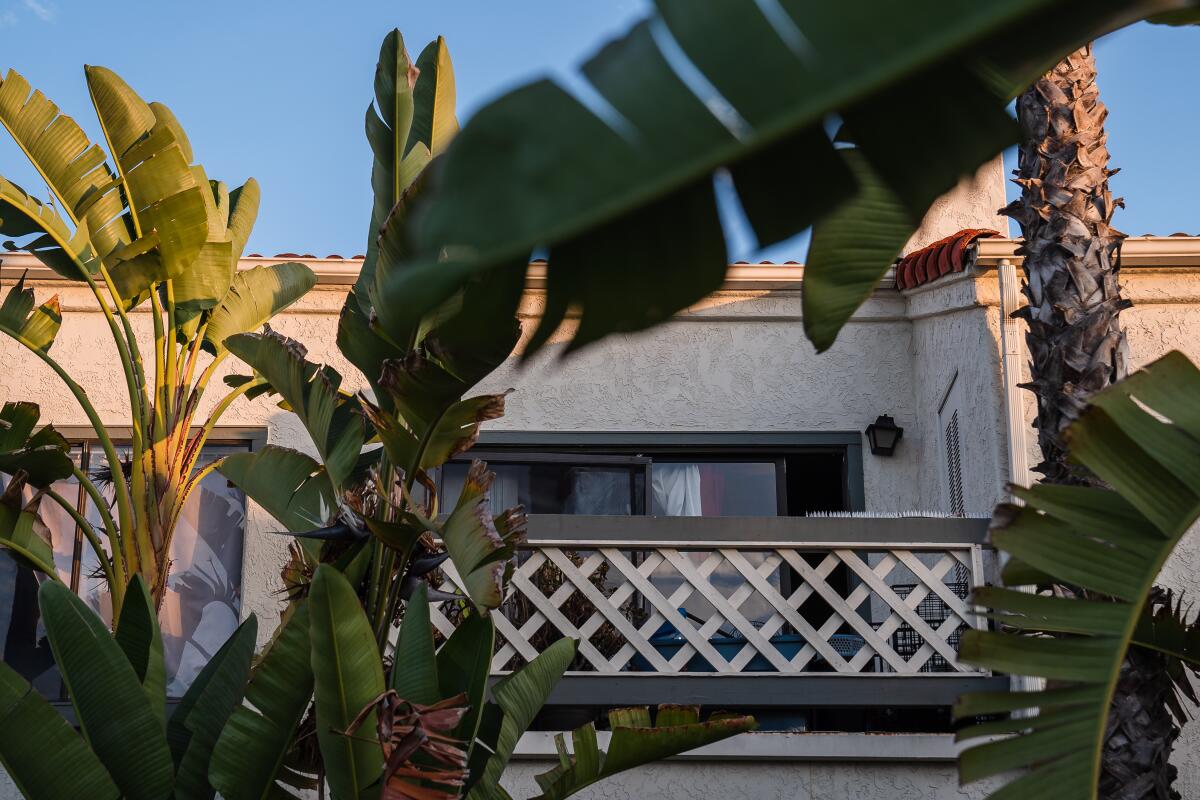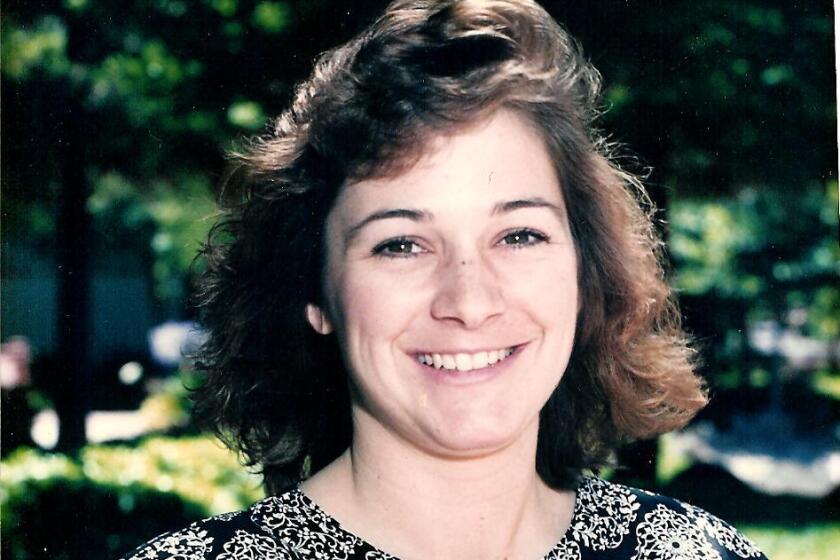‘She shouldn’t have lost her life:’ Neighbors, experts question police response to San Diego break-in

- Share via
SAN DIEGO — A day before 45-year-old Nahal Connie Dadkhah was found dead in her Rancho Peñasquitos condominium, her suspected killer showed up at her door.
It was around 7 p.m. on June 14. Some neighbors saw the man banging on her door and screaming. They were concerned, even afraid — more so when the man broke into Dadkhah’s home through the sliding glass door on the balcony.
Several residents in the condo complex called San Diego police, with one reporting she could hear a fight inside Dadkhah’s residence, according to a record of the calls obtained by the Union-Tribune and interviews with neighbors. The witnesses requested anonymity because of safety concerns and the sensitive nature of the criminal case.
This story is for subscribers
We offer subscribers exclusive access to our best journalism.
Thank you for your support.
Police did not respond immediately. It took officers about an hour and 40 minutes from the time of the first call to show up to the condo on Twin Trails Drive, according to the document. Once officers arrived, they tried to contact Dadkhah and the suspect from outside the unit, to no avail. About 15 minutes after the officers showed up, they walked away.
Nearly 12 hours later, a 911 caller reported Dadkhah was dead.
The new details raise questions about the police response to the disturbance that preceded Dadkhah’s death. One neighbor who called police to report the break-in told the Union-Tribune she believes Dadkhah would be alive if officers had responded sooner, or if they had entered her home to check on her.
“I’m still very angry and disappointed,” the neighbor said. “She shouldn’t have lost her life. [Police are] here to protect us, and I feel like they didn’t do everything they could have to save her.”
Experts say officers are allowed to enter a home without a warrant during emergencies, especially when lives could be in danger.
Kevin Cole, a professor at the University of San Diego School of Law, and Steve Semeraro, a professor at Thomas Jefferson School of Law, said they believe officers had valid reasons to enter Dadkhah’s condo based on neighbors’ reports about the disturbance and burglary.
“This is a pretty troubling account,” Cole said.
In an initial statement about the homicide, police said they responded to a disturbance that involved the suspect — 44-year-old Parrish Chambers — on June 14, a day before Dadkhah’s body was found. Officers tried “various means of communication” to contact Dadkhah and Chambers, but the officers got no response and could not confirm that a crime had occurred, the statement said.
The San Diego Police Department declined to discuss the case with the Union-Tribune. In an interview last week with NBC 7, Lt. Steve Shebloski of the department’s homicide unit said officers “made the best decision ... based on the information at the time.
While many Starbucks customers and workers said they understood concerns around stores given the worsening homelessness crisis and an uptick in crime, some questioned the decision.
“At the end of the day and the following day, did a tragedy happen? Absolutely, but I don’t think that’s because of the officers’ response,” Shebloski told the TV station.
According to police, “a concerned citizen” reported Dadkhah’s death around 8:30 a.m. on June 15. When officers arrived, they saw signs of trauma on the upper portion of her body.
Chambers was in the home. He was arrested and charged with murder.
‘He latched onto her’
A resident in the condo complex told the Union-Tribune that she was reading in bed the morning Dadkhah’s body was found. She heard a man, later identified as Chambers, ask a neighbor outside to call 911 because his “girlfriend” was not breathing, she said.
The San Diego County medical examiner’s office has not determined Dadkhah’s cause of death.
A close friend of the victim said Chambers met Dadkhah about two years ago through an acquaintance of his who attended group therapy at an organization where Dadkhah volunteered.
Shannon Jones, 51, said Dadkhah, who had worked as a medical research assistant and a production manager for a decal manufacturer, never dated Chambers.
“He latched onto her,” said Jones, who said he dated Dadkhah when they met 15 years ago and remained close friends with her after their relationship ended. He said Chambers would show up at Dadkhah’s home on and off.
“He was never a guest at her house,” Jones said. “If he was there it was because she was scared and couldn’t get him to leave.”
Shebloski previously told the Union-Tribune that Chambers was a “frequent visitor” to the condo. The lieutenant did not describe the nature of Chambers’ relationship with Dadkhah.
Jones and several neighbors told the Union-Tribune that there was a history of violence between Dadkhah and Chambers. One neighbor said she called police two to three months ago when she saw Chambers wrap his hands around Dadkhah’s neck in a walkway outside Dadkhah’s condo.
“I was terrified,” the neighbor said, “because I always said, ‘This guy’s going to kill her.’”
Adam Friedman, 32, is accused of setting up a fake social media account for Sharona Nazarian, who was running for the City Council.
Chambers, who remains held on a no-bail status, has pleaded not guilty to the murder charge he faces in San Diego Superior Court.
His attorney, Deputy Public Defender Abram Genser, said that as of last week the county medical examiner’s office had not labeled the case a homicide. Genser said in an email that “it would be easy to jump to conclusions” in light of the charges, adding that charges are not evidence of a crime and that his client is presumed innocent until proved guilty.
Deputy Dist. Atty. Trisha Amador has said in court that the murder case includes 70 pages of discovery concerning a violent history and prior calls to police involving Chambers and Dadkhah. The prosecutor said Chambers was convicted of vandalism in 2020, placed on probation and ordered to stay away from Dadkhah, the victim in that case.
According to court records, Chambers was married between 1986 and 1991. About a year and a half into their marriage, his then-wife was granted a restraining order after she alleged he struck her face twice during an argument.
A disturbance and a break-in
The day before Dadkhah’s body was found, neighbors reported the disturbance around 7 p.m. They told police a man was yelling and banging on Dadkhah’s door, according to the record of the incident.
An hour later, more reports came in. This time neighbors reported that the man had broken into Dadkhah’s condo. Those calls prompted dispatchers to upgrade the priority of the call, according to the documentation of the incident.
Officers staged at a nearby post office before they approached the condo, where they knocked on the front door and called Dadkhah’s and Chambers’ phones, according to the document. Around 9 p.m., officers left.
Several neighbors told the Union-Tribune that the man at Dadkhah’s door seemed intoxicated and angry. They said he was holding a glass bottle.
One neighbor said she called police around 8 p.m. to report the break-in — she said she saw the man shatter the glass sliding door and go inside — and again 40 minutes later to ask why officers had not yet arrived.
Prosecutors say new DNA evidence links John Kevin Woodward to the slaying of Laurie Houts, a 25-year-old computer engineer.
When officers showed up, it was dark. The neighbor said officers had flashlights and a police dog with them. She said officers pounded on Dadkhah’s front door and announced themselves. She saw officers point their flashlights toward the condo, and one officer on the phone, but her windows and doors were closed and she couldn’t hear much.
The neighbor never saw the intruder walk out. She said she was afraid and wanted to know why officers left, so she called the Police Department’s nonemergency line. At a dispatcher’s request, a sergeant called the neighbor. The sergeant told her that officers, based on witness’ descriptions of the suspect, knew who the man was.
The sergeant said officers tried to contact the residents of the condo and said the man lived in the unit. That was inaccurate; Shebloski has indicated the man did not live there.
The neighbor said the sergeant told her to call police if she saw the man again — and not to engage with him.
A delayed police response
The initial reports from neighbors were dispatched as Priority 2 calls. The department tries to respond to Priority 2 calls — disturbances, trespassing and more — within 27 minutes, although officers usually take about two hours to respond, according to fiscal year 2022 city data.
About an hour after the first calls, neighbors reported the break-in, and the incident was upgraded to a Priority 1 call. The department aims to respond to Priority 1 calls — which include burglaries in progress and some serious felonies such as child abuse — in 14 minutes, but the usual wait time is nearly 40 minutes, according to data on response times. Officers showed up to Dadkhah’s door about 40 minutes after the call was upgraded to a Priority 1 call.
Shebloski told NBC 7 that no officers were dispatched in the first hour because it was deemed a lower-priority incident, adding that such calls can stack up.
After the incident was upgraded to a Priority 1 call, officers met up to gather resources, including less-lethal options. Shebloski told the news station that officers were under the impression the man lived at the condo based on police records that showed a history of calls at the home.
Jones, Dadkhah’s friend, said Dadkhah had previously told police that Chambers did not live there and pointed to the stay-away order.
The fact that officers thought the man lived at the condo was a factor in their decision not to enter, Shebloski said.
“When you’re going to force entry into someone’s home, that is the highest level of legal standard we operate under,” the lieutenant told NBC 7. “So you have to be on point legally and tactically. Because if officers go in and make the wrong decision on a poor guy that left his keys in there and broke into his own house and a significant use of force, or God forbid officers use deadly force, there is going to be a lot of hard questions asked of that supervisor and those officers.”
Officers generally need probable cause and a warrant to enter a home, particularly if they are investigating a crime. But, experts said, officers don’t need a warrant to enter a home during exigent circumstances, such as emergencies in which someone is in danger.
Cole and Semerano, the law professors, said officers sometimes are circumspect in deciding whether to enter a home because they want to be sure they don’t enter a home unlawfully. Otherwise they could be sued.
In Dadkhah’s case, Cole and Semerano said they believe there were justifiable grounds for officers to enter her condo.
‘Overflowing with kindness’
Jones remembered his close friend as a compassionate human who was “overflowing with kindness.”
“If you were her friend, she would do anything in her power to help you,” Jones said.
He said she loved animals — she treated her two cats like they were her children. And she enjoyed fashion — she sewed garments in her spare time.
“She just turned out to be one of the greatest people I’ve ever met,” Jones said. “I’m feeling catastrophically sad, knowing that someone as beautiful of a person inside and out can just be taken advantage of like that and not receive help when she needed it. “
More to Read
Sign up for Essential California
The most important California stories and recommendations in your inbox every morning.
You may occasionally receive promotional content from the Los Angeles Times.
















